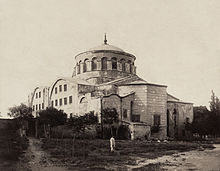This post has already been read 1758 times!
Christmas celebration, which is basically “the mass on Christ’s day” is an event that began after the death of Christ, during the reign of a Roman Emperor Constantine. Prior to his time, Christians were persecuted massively and were killed at their will; however, he was said to have converted to Christianity, thus, applied some break to the killing of Christians in the Roman empire. Being a new convert as it were, he decried Christianity to be the “new religion” of the Roman people. However, one thing was very clear, he did not accept Jesus to replace his former gods; but in addition to his old gods.
Edict of Milan (Wikipedia)
In 313 Constantine and Licinius announced “that it was proper that the Christians and all others should have liberty to follow that mode of religion which to each of them appeared best,”[18] thereby granting tolerance to all religions, including Christianity. The Edict of Milan went a step further than the earlier Edict of Toleration by Galerius in 311, returning confiscated Church property. This edict made the empire officially neutral with regard to religious worship; it neither made the traditional religions illegal nor made Christianity the state religion, as occurred later with the Edict of Thessalonica of 380. The Edict of Milan did, however, raise the stock of Christianity within the empire and it reaffirmed the importance of religious worship to the welfare of the state.[19]
Patronage of the Church (Wikipedia)
Hagia Eirene, the first church commissioned by Constantine in Constantinople.
The accession of Constantine was a turning point for early Christianity. After his victory, Constantine took over the role of patron of the Christian faith. He supported the Church financially, had an extraordinary number of basilicas built, granted privileges (e.g., exemption from certain taxes) to clergy, promoted Christians to high-ranking offices, returned property confiscated during the Great Persecution of Diocletian,[20] and endowed the church with land and other wealth.[21] Between 324 and 330, Constantine built a new imperial capital at Byzantium on the Bosporos, which would be named Constantinople for him. Unlike “old” Rome, the city began to employ overtly Christian architecture, contained churches within the city walls, and had no pre-existing temples from other religions.[22]
In doing this, however, Constantine required those who had not converted to Christianity to pay for the new city.[21] Christian chroniclers tell that it appeared necessary to Constantine “to teach his subjects to give up their rites … and to accustom them to despise their temples and the images contained therein,”[23] This led to the closure of temples because of a lack of support, their wealth flowing to the imperial treasure;[24] Constantine did not need to use force to implement this.[21] Only the chronicler Theophanes has added that temples “were annihilated”, but this was considered “not true” by contemporary historians.[25]
Constantine was the first Roman emperor to convert to Christianity.[notes 1] Although he lived much of his life as a pagan, and later as a catechumen, he joined the Christian faith on his deathbed, being baptised by Eusebius of Nicomedia. He played an influential role in the proclamation of the Edict of Milan in 313, which declared religious tolerance for Christianity in the Roman empire. He called the First Council of Nicaea in 325, which produced the statement of Christian belief known as the Nicene Creed.[4] The Church of the Holy Sepulchre was built on his orders at the purported site of Jesus‘ tomb in Jerusalem and became the holiest place in Christendom. The Papal claim to temporal power in the High Middle Ages was based on the forged Donation of Constantine. He has historically been referred to as the “First Christian Emperor”, and he did heavily promote the Christian Church. Some modern scholars, however, debate his beliefs and even his comprehension of the Christian faith itself.[notes 2]
Wikipedia
If you have carefully read those lines very well; you would realize that the “romance” between the then Church and the Emperor was not without cost. The emperor promised religious tolerance for everyone (including the Christians); therefore, even Christians were expected to TOLERATE the adulteration of their own “religion” by the state. Since the Roman were PAGANS (worshippers of idols – sun god, Mithras, etc.); accepting the Christians only meant that the Christians would also accept them. When came afterwards was a kind of an unholy alliance or marriage between the Pegans and the Christians – the very thing that God frowns at.
Read this material: Source
SUN DAY WORSHIP
Sun-day worship is the setting aside of the first day of the week for the worship of the sun deity, known in Babylon as Tammuz, in Persia as Mithras, in Greece as Helios and in Rome as Sol Invictus, the “unconquerable sun”.
THE ORIGIN OF SUN WORSHIP
Sun worship originated in Babylon with the Bible character known as Nimrod setting himself up as a “mighty one” in the earth by subjugating the population of that time to his authority and control (Genesis 10:8-12). Pagan sources name his wife as Semiramis who became identified as the Queen of heaven. Jewish historical sources state that he was killed by one of the patriarchs because of the evil he was bringing into the earth. (1) After his death, Semiramis his wife, became pregnant and bore a son which was claimed to be of divine origin, having been conceived from the now risen “Nimrod”.
The Bible tells us that there were progeny from the “sons of God” after the era of the flood (Genesis 6:4). The word used for ‘giants’ is Nephilim which means ‘fallen ones’ and there are many instances where these ‘fallen ones’, the progeny of the fallen angels, are mentioned in scripture after the flood. (2)
It seems that the name Tammuz was given to this child of “divine” origin and he became worshiped as the promised messiah for the fallen race of mankind. Being hailed as the life-giver, the one who would revert the curse upon man through faith in him, the solar image, representing the physical giver of life, became a symbol which was used to represent him and in time sun worship developed out of this symbolism.
Nimrod/Tammuz and his mother-wife, Semiramis, founded the great pagan religions centered around this counterfeit representation of the messianic hope of mankind. “Sun worship was the earliest idolatry .” -Fausset Bible Dictionary , p. 666.
Sun-worship became the dominant religion in all ancient civilizations, spreading from Mother Babylon to India, China, Africa, Greece, Rome, Mexico, South America, Egypt and Europe. Historically, pagan Babylon worshipped the sun as a deity, and pagan religions also worshipped the invincible sun. The first day of the week, the most pre-eminent position in the week, was therefore given to the worship of the sun in the calendar of the ancients. Worshipping on Sunday goes back at least two thousand years before Christ. It was from this false sun-worship that we get the name ‘Sunday’ – i.e. sun-day, in our calendar for the first day of the week.
“Sunday is the first day of the week, adopted from the Roman calendar because it was dedicated to the worship of the sun.” [Unger’s Bible Dictionary under the article “Sunday”]
Babylon is the mother of all “harlot” religions and all the pagan abominations and false worship systems that exists on earth!
THE INFILTRATION OF THE CHURCH
Sun worship was a very prominent religion at the time of Christ and Sunday was the main day of worship in the pagan Roman Empire, just as it was in ancient pagan Babylon.
“Sun worship was one of the oldest components of the Roman religion.” [Gaston H. Halsberge, The Cult of Sol Invictus, 1972, p. 26.]
Pagan Babylon’s rituals, customs and sun worship began to infiltrate the church in the first two centuries through Greek philosophy. But it was not until the time of Constantine, that it had a major effect when he made “Christianity” the state religion and incorporated the traditions associated with the worship of the sun into his legislations for Church practice. He changed the observance of the Sabbath to the first day of the week, in honour of the “Invincible Sun” by civil law, and filled the church with the commonly used pagan holy days, images and symbols of the sun.
The Interpreter’s Dictionary of the Bible’ emphasizes the motive of Constantine for legislating Sunday as a day of rest, and stresses, “Indeed, this god” (the sun god) “was the titulary divinity of Constantine’s family, and from the fourth century there is an increasing assimilation of Christ to the Sun-god (as Sun of Righteousness), the Christos Helios (cf. Eusebius Life of Constantine 1.4.18; and the notable mosaic of Christos Helios recently uncovered in the tomb of the Julii under the Vatican).”
Constantine who reigned from 306-337, called the Sun-deity: “Unconquered Sun, my companion.” His edict in the year 321 legislated the “venerable day of the Sun” to be a rest-day. This rest was commanded in honour of the sun-god, and not in honour of the Messiah, the Son.
“On the Venerable Day of the Sun (“Venerable die Solis” -the sacred day of the Sun) let the magistrates and people residing in cities rest, and let all workshops be closed. In the country, however, persons engaged in agriculture may freely and lawfully continue their pursuits; because it often happens that another day is not so suitable for grain-sowing or for vine-planting; lest by neglecting the proper moment for such operations the bounty of heaven should be lost- given the 7th day of March [A.D. 321], Crispus and Constantine being consuls each of them for the second time.” [The First Sunday Law of Constantine I, in “Codex Justianianus,”lib. 3, tit. 12, 3; trans. in Phillip Schaff, History of the Christian Church, Vol. 3, p. 380]
Eusebius, his supporter, says, ” All things whatsoever that were prescribed for the Sabbath, we have transferred them to the Lord’s day, as being more authoritative and more highly regarded and first in rank, and more honorable than the Jewish Sabbath.” [Bishop Eusebius, quoted in J. P. Migne, “Patrologie,” p. 23,1169-1172 (Eusebius of Caesarea was a high-ranking Catholic leader during Constantine’s lifetime]
This change-over to Sunday by the Church took place in the year 336 and was the first law passed to legalise Sunday-keeping (some authorities give the date as 364) at the Council of Laodicca, Canon 29:
“Christians shall not Judaize and be idle on Saturday (in the original: ‘sabbato’ -shall not be idle on the Sabbath), but shall work on that day; but the Lord’s day they shall especially honour, and as being Christians, shall, if possible, do no work on that day. If, however, they are found Judaizing, they shall be shut out (‘anathema,’ excommunicated) from Christ.” [ Council of Laodicea, c. A.D. 337, Canon 29, quoted in C. J. Hefele, A History of the Councils of the Church, Vol. 2, p. 316]
However, Christians continued to observe the seventh-day Sabbath at least as late as the middle of the fifth century A.D. 450. Socrates made this statement 100 years after Constantine’s Sunday Law was passed: “Although almost all churches throughout the world celebrate the sacred mysteries on the Sabbath every week, yet the Christians of Alexandria and at Rome, on account of some ancient tradition, have ceased to do this.” -Socrates Scholasticus, quoted in Ecclesiastical History, Book 5, chap. 22 [written shortly after A.D. 439].
Also as quoted by Sozomen, “The people of Constantinople, and almost everywhere, assemble together on the Sabbath, as well as on the first day of the week, which custom is never observed at Rome or at Alexandria” [Ecclesiastical History, vii, 19, in A Select Library of Nicene and Post-Nicene Fathers, 2nd Series, Vol. 2, p. 390 (written soon after A.D. 415)].
But gradually the influence and power of the Roman Church grew, sup ported by political and civil authorities with their power and the strong anti-Judaism that prevailed. Sabbath-keeping dwindled until there was but a scattered and persecuted remnant left.
In the 5th century, the Messiah was not only called “the True Sun,” but also “the true Apollo,”‘ the age- old Sun-deity of the Greeks. The adoption of Sunday instead of the Sabbath, became a contributory factor in the assimilation of our Saviour to the Sun, even the Sun as deity, Him being made into Christos Helios, Christ the True Sun, Christ the Eternal Sun.
Many of the pagan sunburst images used by the church show up in various forms of church art. The art-forms of the time in paintings and pictures, as well in statues and images, depicted our Messiah with sun-rays or a nimbus (sun-disc) about His head. There are a great number of these illustrations to be found in ecclesiastical books. In a large number of the traditional churches altars there are the same general Babylonian sun symbol. Some have tapestry with a sunburst design nearly identical to the pagan sun-god symbol of Baal/Shamash. This tapestry is called the altar frontal, antipendium, or pallium altaris.
ISRAEL AS AN EXAMPLE
In the great temple of Babylon, the golden image of the Sun was exhibited for the worship of the Babylonians. In Egypt, the disk of the Sun was represented in the temples, and the sovereign and his wife and children were represented as adoring it. In the worship of Baal, as practised by the idolatrous Israelites in the days of their apostasy, the worship of the sun’s image was equally observed; and it is striking to find that the image of the sun, which apostate Israel worshipped, was erected above the altar (3).
So the false religion of sun worship in Israel was Baal and it all came from the same source, from ‘Babylon’. In their worship of Baal, they profaned the Sabbath and worshiped on the first day of the week, the sun day instead of God’s worship day, the seventh day of the week. For this, Yahweh brought a charge against them and judged them.
“Moreover, they have done this to Me: They have defiled My sanctuary on the same day and profaned My Sabbaths.” (Ezekiel 23:38) And for this He brought the Babylonians against them to defile their sanctuary and allow the land her Sabbaths: “to fulfill the word of Yahweh by the mouth of Jeremiah, until the land had enjoyed her Sabbaths. As long as she lay desolate she kept Sabbath, to fulfill seventy years.” 2 Chronicles 36:21
God had forbidden them to bring any of the objects of Baal worship into their tents or homes, and He especially commanded that none of their pagan customs ever be used in connection with His worship. “The graven images of their gods shall ye burn with fire: thou shalt not desire the silver or gold that is on them, nor take it unto thee…. Neither shalt thou bring an abomination into thine house, lest thou be a cursed thing like it.” Deuteronomy 7:25, 26.
He also commanded “Take heed to yourself that you are not ensnared to follow after them (the way the nations worship their gods) .. .. .. and that thou inquire not after their gods, saying, How did these nations serve their gods? even so will I do likewise.” Deuteronomy 12:30.
The Israelites were also warned not to adopt pagan religious practices that God viewed as abominations. “You shall not worship the Lord your God in that way: .. .. .. “Whatever I command you, be careful to observe it; you shall not add to it nor take away from it.” (Deuteronomy 12:31a, 32).
How does He relate to worship on Sunday which was transferred directly from pagan Baal sun worship to honour the Antichrist system of Babylonian worship?
“So he carried me away in the spirit into the wilderness: and I saw a woman sit upon a scarlet colored beast, full of names of blasphemy, having seven heads and ten horns. And the woman was arrayed in purple and scarlet color, and decked with gold and precious stones and pearls, having a golden cup in her hand full of abominations and filthiness of her fornication: And upon her forehead was a name written, Mystery, Babylon the Great, the mother of Harlots and abominations of the earth ” (Revelation 17:3-5.).
Notes: 1. Book of Jasher Vol.1; Ch.37
2. Numbers 13:33; Deuteronomy 2:11, 20; 3:11-13; Joshua 12:4; 13:12; 15:8; 17:15; 18:16; 1Chronicles 20:4-8; 2 Samuel 21:16-22
3. When the good king Josiah set about the work of reformation, we read that his servants in carrying out the work, proceeded thus (2 Chronicles 34:4): “And they brake down the altars of Baalim in his presence, and the images (margin, sun images) that were on high above them, he cut down…. ” ‘Bold text’
Although, I knew about the things discussed in the video above; but I guess I was careless to have planted a tree that symbolizes something I wasn’t conscious of. Since ignorance isn’t an excuse in court; I decided to cut down these tree I had planted in my compound. We must all be careful before our entire lives are infiltrated by the artifacts and the devices of the powers of darkness. May the Lord Jesus Christ purge us all as His Church on earth in Jesus name!




Source: Centre for New Dimension Leadership




